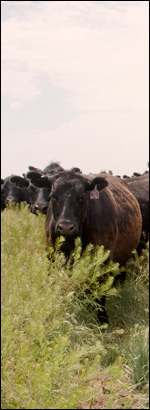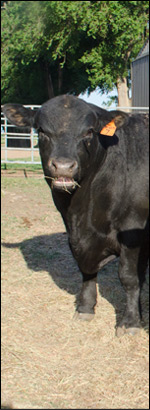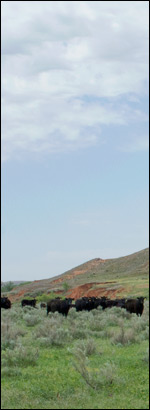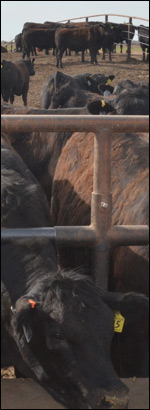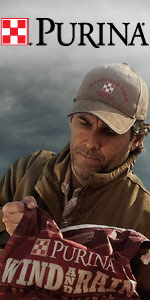Establishing a Home in America
Nearly 140 years ago, four Angus bulls were brought to the United States. Their final destination — Victoria, Kan. — became the birthplace of the nation's most popular breed.
Adapted from "Cradle of Angus in America," by Brad Parker. To see the full story, click here.
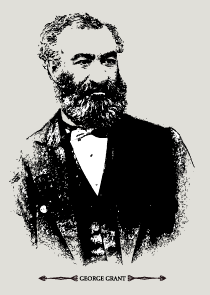 A noble dream
A noble dream
The father of the American Angus, George Grant was a cloth merchant in Banffshire, Scotland. Some say it was his life's ambition, others say it was doctor's orders, but something brought Grant to America in 1871. He traveled the country from New England to California and back again. On the return trip, he fell in love with the virgin prairies of Kansas, particularly that stretch between Hays and Russell.
He convinced the Kansas Pacific Railroad to sell him 2,500 acres of its right-of-way, and by the next year Grant had amassed 69,000 acres. Most reports say he spent around 88¢ per acre, although some estimates go as high as $2.
Grant promised the railroad that he would "people these prairies with the best blood of England." He sold most of the acreage to wealthy English families for around $11 per acre, promising that life on the Kansas plains would help their pampered sons become hardy men.
To ensure that only the upper class settled in his colony, he eventually required buyers to purchase an entire section, 640 acres. He convinced the railroad to build a combination grocery store, hotel and post office on the land, and he named it Victoria Manor to honor his queen.
Coming to America
On April 1, 1873, the steamship Alabama pulled away from Glasgow, Scotland, glided down the Clyde River, and began its journey across the Atlantic Ocean and the Gulf of Mexico. It arrived in New Orleans, carrying the first 30 or so colonists, livestock and supplies bound for Victoria.
Included
in the livestock were four Angus bulls. At the time, those bulls probably were considered of minor importance to the entire undertaking, but they "later proved to be the most lasting contribution of the colony to American agriculture and the means of giving the venture historical importance," wrote Otto Battles in the March 1942 Aberdeen-Angus Journal.
Battles went on to write that there didn't seem to be any authentic record of the bulls' pedigrees; but John MacDonald, who had charge of them during the journey, stated that he thought at least two of them were from the McCombie herd in Scotland. MacDonald, being an experienced cattleman, did attest that all four were good individuals; and, in Battle's words, "history has proved them to have been good sires."
These bulls weren't the only Angus brought from Scotland under Grant's direction. At least one other shipment was made. On May 10, 1876, the steamship City of Limerick left Liverpool for Philadelphia. Among the cattle, sheep and dogs on board were four Angus heifers and another bull, Royal George. He was a son of Royal Benedict from the Booth herd; and his dam was Cream the Fourth, also known as "England's Glory," for she was the pick of the queen's herd at the Home Farm in Windsor.
Grant exhibited the five animals at the Great Centennial Show in Philadelphia before bringing them home to Victoria.
Proven worth
In the 1800s, Shorthorn cattle were considered the most useful breed for the New World. Grant's Angus were thought to be freaks because of their color and lack of horns. Many referred to their introduction to the Scotsman's herd as one of his idiosyncrasies.
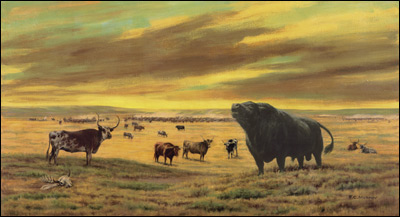
In 1973, Frank C. Murphy's painting of the first Angus bull imported from Scotland appeared on the 8-cent postage stamp to commemorate the 100th anniversary of Angus in the U.S.
In the beginning, the only heifers about Grant's ranch were Texas longhorns. The resulting calves proved hardy stock, as did their sires, through the rigors of winter on the open plains.
Not only were the cattle productive, they were consistent. The vast majority of the calves were polled and black. One visitor to the Grant herd wrote, "In driving through a herd of 800 head, it was singularly remarkable to see red, dun and even light mixed-colored cows, with the calves jet black, hornless and otherwise so perfectly resembling the sire. This is a most favorable recommendation of their blood."
The visitor went on to comment that the sires were from the herd of George Brown, Morayshire, Scotland. Whether these were among the first four bulls or were later imports has been lost to history.
That uniformity made the breed popular among cattlemen, livestock judges and marketers throughout the Midwest. Many calves were sent to feedlots in the Corn Belt, where they were highly favored because they gained weight quickly, then brought high prices as finished cattle.
Grant's Angus stock made impressions at the stock shows in Kansas City and Chicago. Although there are no records of their winning any prizes, they gained a lot of attention, especially in carcass classes.
The legacy
Five years after the founding of his colony, on April 28, 1878, Grant died at age 56. His cattle were dispersed throughout the Kansas City trade area. Several of Grant's animals were purchased by Joseph Rea, Carroll County, Mo., who would himself soon become a well-known breeder and importer of Angus cattle.
Although Grant was dead and his herd was scattered to the winds, the popularity of the Angus breed had taken root. By the early 1880s, large numbers of them were being imported, and the U.S. beef industry never would be the same.

